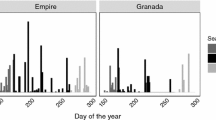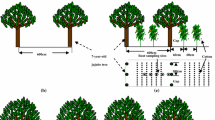Abstract
Understanding the belowground interactions between trees and crops is critical to successful management of agroforestry systems. In a study of competition for water in an alley cropping system consisting of pecan (Carya illinoensis) and cotton (Gossypium hirsutum) in a sandy loam soil (Rhodic Paleudult) in Jay, Florida, root systems of the two species were separated by trenching to 120 cm depth. A polyethylene barrier was installed in half of the plots. Spatial and temporal variations in soil water content, root distribution and water uptake by both species, and leaf area development and height of cotton were measured. Interspecific competition for water was greater in the non-barrier treatment near tree rows than at the alley center. Competition became evident 3 to 4 weeks after emergence of cotton and increased during the following 7 to 8 weeks. Compared with the non-barrier treatment, the barrier treatment had higher soil water content and better growth of cotton (height, leaf area, and fine root biomass). Cotton lint yield in the barrier treatment (677 kg ha–1) was similar to that in a sole-crop stand, but higher than in the non-barrier (502 kg ha–1) treatment. Lint production efficiency of plants was higher in the interior rows in the non-barrier treatment (0.197 kg lint per square meter of leaf area, compared to 0.117 kg in the barrier treatment). The results suggest that trenching or even deep disking parallel to the tree row may reduce competition for water, but the impact on tree growth cannot be established from this study.
Similar content being viewed by others
References
Ball R.A., Oosterhuis D.M. and Mauromoustakos A. 1994. Growth dynamics of the cotton plant during water deficit stress. Agron. J. 86: 788–795.
Bassett D.M., Stockton J.R. and Dickens W.L. 1970. Root growth of cotton as measured by P 32 uptake. Agron. J. 60: 200–203.
Dana M.N. and Lerner B.R. 2001. Black Walnut toxicity. Purdue University Cooperative Extension Service Paper General Horticulture HO-193-W.
Dugas W.A., Heuer M.L., Hunsaker D., Kinbal B.A., Lewin K.F., Nagy J. and Johnson M. 1994. Sap flow measurements of transpiration from cotton grown under ambient and enriched CO2 concentrations. Agric. For. Meteorol. 70: 231–245.
Gillespie A.R., Jose S., Mengel D.B., Hoover W.L., Pope P.E., Seifert J.R., Biehle D.J., Stall T. and Benjamin T.J. 2000. Defining competition vectors in a temperate alley cropping system in the midwestern USA; 3. Production physiology. Agrofor. Syst. 2000, 48: 25–40.
Govindarajan M., Rao M.R., Mathuva M.N. and Nair P.K.R. 1996. Soil-water and root dynamics under hedgerow intercropping in semiarid Kenya. Agron. J. 88: 513–520.
Granier A. 1985. Une nouvelle methode pour la mesure du flux de seve brute dans le tronc des arbes. Annales des Sciences Forestieres 42: 193–200.
Ham J.M., Heilman J.L. and Lascano R.J. 1990. Determination of soil water evaporation and transpiration from energy balance and stem flow measurements. Agric. and For. Meteorol. 52: 287–301.
Jose S., Gillespie A.R., Seifert J.R. and Biehle D.J. 2000a. Defining competition vectors in a temperate alley cropping system in the Midwestern USA 2. Competition for water. Agrofor. Syst. 48: 41–59.
Jose S., Gillespie A.R., Seifert J.R. and Biehle D.J. 2000b. Defining competition vectors in a temperate alley cropping system in the Midwestern USA; 3. Competition for nitrogen and litter decomposition. Agrofor. Syst. 2000 48: 61–77.
Lascano R.J., Baumhardt R.L., Stanley K.H. and Heilman J.L. 1994. Soil and plant water evaporation from strip-tilled cotton; measurement and simulation. Agron. J. 86: 987–994.
Lehmann J., Peter I., Steglich C., Gebauer G., Huwe B. and Zech W. 1998. Belowground interactions in dryland agroforestry. For. Ecol. and Manage. 111: 157–169.
Lu P. 1997. A direct method for estimating the average sap flux density using a modified Granier measureing system. Austr. J. of Plant Physiol. 24: 701–705.
McMichael B.L. and Hesketh J.D. 1982. Field investigations of the response of cotton to water deficits. Field Crop. Res. 5: 319–333.
Miller A.W. and Pallardy S.G. 2001. Resource competition across the crop-tree interface in a maize-silver maple temperate alley cropping stand in Missouri. Agrofor. Syst. 53: 247–259.
Ong C.K., Black C.R., Marshall F.M. and Corlett J.E. 1996. Principles of resource capture and utilization of light and water. In: Ong C.K. and Huxley P.A. (eds), Tree-Crop Interactions-A Physiological Approach, CAB International.
Ramsey C.L. and Jose S. 2002. Management challenges of pecan and pine based alley cropping systems of the Southern United States. In: Schroder W. and Kort J. (eds), Temperate Agroforestry: Adaptive and mitigative roles. Plaines and Prairie Forestry Association, Regina, Canada. pp. 158–163.
Sakurantani T. 1981. A heat balance method for measuring water flux in the stem of intact plants. Journal of Agric. and For. Meteorol. 37: 9–17.
Singh R.P., Ong C.K. and Saharan N. 1989. Above and below ground interactions in alley cropping in semiarid India. Agrofor. Syst. 9: 259–274.
Sorensen R.B. and Jones T.L. 1999. Soil water uptake patterns of pecan trees grown in coarse gravelly soils. Horttech 9(3): 402–408.
Sorensen R.B., Jones T.L., Campbel G.S. and Montes-Helu M. 1999. Heat pulse needles to measure pecan tree transpiration. Am. Soc. Agric. Eng. 15(6): 651–657.
Wolstenholme B.N. 1979. The ecology of pecan trees: Part 1. Characteristics of native habitat. Pecan. Quart. 13: 32–35.
Author information
Authors and Affiliations
Corresponding author
Rights and permissions
About this article
Cite this article
Wanvestraut, R.H., Jose, S., Nair, P.R. et al. Competition for water in a pecan (Carya illinoensis K. Koch) – cotton (Gossypium hirsutum L.) alley cropping system in the southern United States. Agroforestry Systems 60, 167–179 (2004). https://doi.org/10.1023/B:AGFO.0000013292.29487.7a
Issue Date:
DOI: https://doi.org/10.1023/B:AGFO.0000013292.29487.7a




